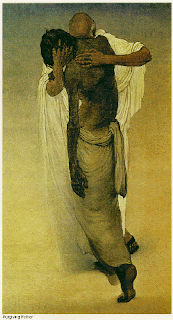I wanted to provide some information about a great 20th century Indian Christian artist named Frank Wesley (1923-2002). The following five paragraphs are directly quoted from the Kerrmuller Collection Art Gallery:
 |
| Forgiving Father |
Wesley was a 5th generation Christian (Methodist). He was an Indian artist, expressing the Christian story and its meaning within a framework of an Indian setting, with an Indian imagination, and starting from the painting styles and techniques of his indigenous culture, particularly the Lucknow watercolour school technique and the Bengal Renaissance style. This was expanded through other Asian and western influences from several years of study also in Japan and the USA. Although his Christianity was formed in the Methodist tradition, his choice of religious themes was not confined to that of Protestant art (Rembrandt was an important artist for him), and he drew upon the visual traditions of Catholicism in European art and sought to re-interpret Indian religious iconography with Christian reference. Wesley often spoke of his rejection for Asia of the “fair-haired, blue-eyed Jesus” image, which so often appeared in the publications brought by the missionaries.
Frank Wesley would often say that he was not interested in illustrating the biblical stories. He understood illustration to be the depiction of a scene as it may be observed with detachment. He set out to search for and express meanings, using both traditional and personal symbolism and all the possibilities offered by the techniques he used. He saw himself as not an artist with one technique and style, but as one who chose a style to be a fitting component of the depiction of the subject matter or theme.
Although his Christianity was formed in the Methodist tradition, his choice of religious themes was not confined to that of Protestant art (Rembrandt was an important artist for him), and he drew upon the visual traditions of Catholicism in European art and sought to re-interpret Indian religious iconography with Christian reference.
 |
| Mary Goes to Visit Elizabeth |
* * *
Another example of Wesley's work that shows a Japanese influence is "Home in Nazareth."
 |
| Home at Nazareth |
 |
| The 53 Stations of the Tokaido Road by Hiroshige |
The holy family and various elements in the painting set it in India. And, of course, Jesus is blue, like Krishna, who is often portrayed in his child form.
Jan Peter Schouten writes, “When viewing this painting, a Hindu would without doubt think immediately of Krishna... the little, playful Krishna is a very specific figure within Hindu spirituality.” In this sense, Schouten writes, Wesley is portraying Jesus as an avatar like Krishna. An avatar is the Indian concept of the incarnation, when a god deliberately descends from higher spiritual realms to lower realms of existence for special purposes. However, there are differences between this and the biblical idea of incarnation, though I don't know them just yet! But by portraying Jesus as blue, as Schouten writes, “Wesley's Jesus is completely God from the very first moment of his life, just like Krishna.”
Jesus' forehead is shown in gold, with the knowledge of God's will. This is an interesting motif in many of Wesley's paintings of Christ (and his first use of it in this painting), which I think is a wonderful symbolic representation of his Godhood.
To read more about Wesley and to see the most exhaustive collection of his work and life, please purchase Frank Wesley: Exploring Faith With A Brush by Naomi Wray. (If you're seriously interested in getting a copy cheaper than those listed here, contact me and I'll see if the author still lives here in Asheville, NC, and has copies available). You can also view some small thumbnails of his work here and here.




Naomi Wray, the author of Frank Wesley: Exploring Faith With A Brush, no longer has any copies available of this out of print book.
ReplyDeleteIt's a real pity. A beautiful book of paintings by a master. I'm deeply moved by him.
DeleteI met Mr Wesley once in the mid-1980s at his home on the Sunshine Coast. A fascinating, thoughtful, gentle man who left a lasting impression. I was on friendly terms with his son and daughter (Michael and Nasim) and spent a memorable weekend at his home. He and his wife were perfect hosts and after an evening meal of pizza, salad and red wine we talked for hours about art, music and ideas. A cultured household. I'm delighted to see his work is finally receiving the attention it deserves. May he rest in peace.
ReplyDeleteHe's amazing. I would love to meet his children.
Delete